Juan Gris
| Juan Gris | |
|---|---|
 Juan Gris, 1922, photograph by Man Ray (Paris) | |
| Born |
José Victoriano González-Pérez March 23, 1887 Madrid |
| Died |
May 11, 1927 (aged 40) Boulogne-sur-Seine |
| Nationality | Spanish |
| Known for | Painting, sculpture |
| Movement | Cubism |
José Victoriano (Carmelo Carlos) González-Pérez (March 23, 1887 – May 11, 1927), better known as Juan Gris (Spanish: [ˈxwan ˈɡɾis]; French: [gʀi]), was a Spanish painter and sculptor born in Madrid who lived and worked in France most of his life. Closely connected to the innovative artistic genre Cubism, his works are among the movement's most distinctive.
Early life
Gris was born in Madrid. He later studied engineering at Madrid's School of Arts and Sciences. There, from 1902 to 1904, he contributed drawings to local periodicals. From 1904 to 1905, he studied painting with the academic artist José Moreno Carbonero. It was in 1905 that José Victoriano González adopted the more distinctive name Juan Gris.[1]
Career
In 1906 he moved to Paris and became friends with Henri Matisse, Georges Braque and Fernand Léger. In Paris, Gris followed the lead of another friend and fellow countryman, Pablo Picasso. He submitted darkly humorous illustrations to journals such as the anarchist satirical magazine L'Assiette au Beurre, and also Le Rire, Le Charivari, and Le Cri de Paris.
Gris began to paint seriously in 1910 (when he gave up working as a satirical cartoonist), developing at this time a personal Cubist style. In A Life of Picasso, John Richardson writes that Jean Metzinger's 1911 work, Le goûter (Tea Time), persuaded Juan Gris of the importance of mathematics in painting.[2] Gris exhibited for the first time at the 1912 Salon des Indépendants (a painting entitled Hommage à Pablo Picasso).[3]
"He appears with two styles", writes art historian Peter Brooke, "In one of them a grid structure appears that is clearly reminiscent of the Goûter and of Metzinger's later work in 1912."[3] In the other, Brooke continues, "the grid is still present but the lines are not stated and their continuity is broken. Their presence is suggested by the heavy, often triangular, shading of the angles between them... Both styles are distinguished from the work of Picasso and Braque by their clear, rational and measurable quality."[3] Although Gris regarded Picasso as a teacher, Gertrude Stein wrote in The Autobiography of Alice B. Toklas that "Juan Gris was the only person whom Picasso wished away".[4]
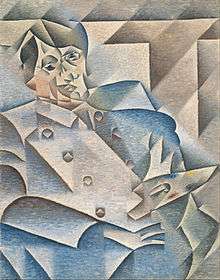
In 1912 Gris exhibited at the Exposicío d'art cubista, galeríes J. Dalmau in Barcelona; the gallery Der Sturm in Berlin; the Salon de la Société Normande de Peinture Moderne in Rouen; and the Salon de la Section d'Or in Paris. Gris, in that same year, signed a contract that gave D.-H. Kahnweiler exclusive rights to his work.[5]
At first Gris painted in the style of Analytical Cubism, a term he himself later coined,[6] but after 1913 he began his conversion to Synthetic Cubism, of which he became a steadfast interpreter, with extensive use of papier collé or, collage. Unlike Picasso and Braque, whose Cubist works were practically monochromatic, Gris painted with bright harmonious colors in daring, novel combinations in the manner of his friend Matisse. Gris exhibited with the painters of the Puteaux Group in the Salon de la Section d'Or in 1912.[7] His preference for clarity and order influenced the Purist style of Amédée Ozenfant and Charles Edouard Jeanneret (Le Corbusier), and made Gris an important exemplar of the post-war "return to order" movement.[8] In 1915 he was painted by his friend, Amedeo Modigliani.
Crystal Cubism
%2C_oil_on_canvas%2C_92_x_60_cm%2C_Kunstmuseum_Basel.jpg)
Gris's works from late 1916 through 1917 exhibit a greater simplification of geometric structure, a blurring of the distinction between objects and setting, between subject matter and background. The oblique overlapping planar constructions, tending away from equilibrium, can best be seen in Woman with Mandolin, after Corot (September 1916) and in its epilogue, Portrait of Josette Gris (October 1916; Museo Reina Sofia).[9]
The clear-cut underlying geometric framework of these works seemingly controls the finer elements of the compositions; the constituent components, including the small planes of the faces, become part of the unified whole. Though Gris certainly had planned the representation of his chosen subject matter, the abstract armature serves as the starting point. The geometric structure of Juan Gris's Crystal period is already palpable in Still Life before an Open Window, Place Ravignan (June 1915; Philadelphia Museum of Art). The overlapping elemental planar structure of the composition serves as a foundation to flatten the individual elements onto a unifying surface, foretelling the shape of things to come. In 1919 and particularly 1920, artists and critics began to write conspicuously about this 'synthetic' approach, and to assert its importance in the overall scheme of advanced Cubism.[9]
Designer and theorist
In 1924, he designed ballet sets and costumes for Sergei Diaghilev and the famous Ballets Russes.
Gris articulated most of his aesthetic theories during 1924 and 1925. He delivered his definitive lecture, Des possibilités de la peinture, at the Sorbonne in 1924. Major Gris exhibitions took place at the Galerie Simon in Paris and the Galerie Flechtheim in Berlin in 1923 and at the Galerie Flechtheim in Düsseldorf in 1925.
Death
After October 1925, Gris was frequently ill with bouts of uremia and cardiac problems. He died of renal failure[10] in Boulogne-sur-Seine (Paris) on May 11, 1927, at the age of 40, leaving a wife, Josette, and a son, Georges.
Art market
The top auction price for a Gris work is $57.1 million (£34.8 million), achieved for his 1915 painting Nature morte à la nappe à carreaux.[11] This surpassed previous records of $20.8 million for his 1915 still life Livre, pipe et verres and $28.6 million for the 1913 artwork Violon et guitare.[12]
Selected works
- Bottle of Rum and Newspaper (Bouteille de rhum et journal) at the Guggenheim Museum
- Cherries (Les cerises) at the Guggenheim Museum
- Fruit Dish on a Checkered Tablecloth (Compotier et nappe à carreaux) at the Guggenheim Museum
- Violin Hanging on a Wall (Le violon accroché) at the Guggenheim Museum
Gallery
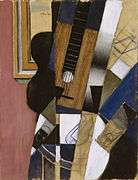 Guitar and Pipe, 1913, Dallas Museum of Art, Texas
Guitar and Pipe, 1913, Dallas Museum of Art, Texas Glass of Beer and Playing Cards, 1913, Columbus Museum of Art, Ohio
Glass of Beer and Playing Cards, 1913, Columbus Museum of Art, Ohio Violin and Checkerboard, 1913, Private collection
Violin and Checkerboard, 1913, Private collection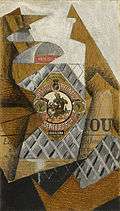 The Bottle of Anís del Mono, 1914, Queen Sofia Museum, Madrid
The Bottle of Anís del Mono, 1914, Queen Sofia Museum, Madrid- Fantômas, 1915, National Gallery of Art, Washington, D.C.
%2C_oil_on_canvas%2C_116.5_x_89.3_cm.jpg) Nature morte à la nappe à carreaux (Still Life with Checkered Tablecloth), 1915, Metropolitan Museum of Art, New York
Nature morte à la nappe à carreaux (Still Life with Checkered Tablecloth), 1915, Metropolitan Museum of Art, New York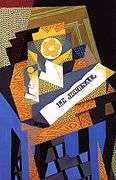 Newspaper and Fruit Dish, 1916, Yale University Art Gallery, New Haven, CT
Newspaper and Fruit Dish, 1916, Yale University Art Gallery, New Haven, CT Fruit Dish on a Checkered Tablecloth, 1917, Solomon R. Guggenheim Museum, New York
Fruit Dish on a Checkered Tablecloth, 1917, Solomon R. Guggenheim Museum, New York The Guitar (La Guitarra), 1918, Fundación Telefónica
The Guitar (La Guitarra), 1918, Fundación Telefónica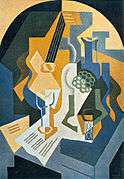 Still Life with Fruit Dish and Mandolin, 1919, Private collection, Paris
Still Life with Fruit Dish and Mandolin, 1919, Private collection, Paris Harlequin with Guitar, 1919, Centre Pompidou, Paris
Harlequin with Guitar, 1919, Centre Pompidou, Paris Le Canigou, 1921, Albright-Knox Art Gallery, Buffalo, New York
Le Canigou, 1921, Albright-Knox Art Gallery, Buffalo, New York The Painter's Window, 1925, Baltimore Museum of Art, Maryland
The Painter's Window, 1925, Baltimore Museum of Art, Maryland
Notes
- ↑ Gris 1998, p. 124.
- ↑ John Richardson: A Life of Picasso, volume II, 1907-1917, The Painter of Modern Life, Jonathan Cape, London, 1996, p.211
- 1 2 3 "Peter Brooke, On "Cubism" in context, online since 2012". Retrieved 19 September 2014.
- ↑ After Gris' death, Stein said to Picasso, "You never realized his meaning because you did not have it", to which Picasso replied, "You know very well that I did". Caws, Mary Ann (2005). Pablo Picasso. Reaktion Books. ISBN 1-86189-247-0. p. 66
- ↑ "Peggy Guggenheim Collection, Lucy Flint-Gohlke, Thomas M. Messer, Handbook, the Peggy Guggenheim Collection, Solomon R. Guggenheim Foundation, Abrams, 1983". Internet Archive. Retrieved 19 September 2014.
- ↑ Honour, H. and J. Fleming, (2009) A World History of Art. 7th edn. London: Laurence King Publishing, p. 784. ISBN 9781856695848
- ↑ Cooper, Philip. Cubism. London: Phaidon, 1995, p. 56. ISBN 0714832502
- ↑ Cowling and Mundy 1990, p. 117
- 1 2 Christopher Green, Cubism and its Enemies, Modern Movements and Reaction in French Art, 1916–1928, Yale University Press, New Haven and London, 1987, pp. 13-47
- ↑ Green, Oxford Art Online: "Juan Gris"
- ↑ "Juan Gris (1887-1927) | Nature morte à la nappe à carreaux | Impressionist & Modern Art Auction | 20th Century, Paintings | Christie's". Christies.com.cn. Retrieved 2014-02-04.
- ↑ "Juan Gris (1887-1927) | Violon et guitare | Impressionist & Modern Art Auction | 20th Century, Paintings | Christie's". Christies.com.cn. Retrieved 2012-03-23.
References
- Cowling, Elizabeth; Mundy, Jennifer. 1990. On Classic Ground: Picasso, Léger, de Chirico and the New Classicism 1910-1930. London: Tate Gallery. ISBN 1-85437-043-X
- Green, Christopher. "Gris, Juan." Grove Art Online. Oxford Art Online. Oxford University Press. Web.
- Gris, Juan. 1998. Juan Gris: peintures et dessins, 1887-1927. [Marseille]: Musées de Marseille. ISBN 2-7118-2969-3. (French language)
External links
| Wikiquote has quotations related to: Juan Gris |
| Wikimedia Commons has media related to Juan Gris. |
- Juan Gris, Joconde, Portail des collections des musées de France
- Juan Gris, Culture.gouv.fr, le site du Ministère de la culture - base Mémoire
- Artcyclopedia - Links to Gris' works
- The Athenaeum - Extensive list and images of Gris' works
- Juan Gris in Artfacts.Net See actual exhibitions and related galleries and museums for Juan Gris
- Juan Gris in American public collections, on the French Sculpture Census website

